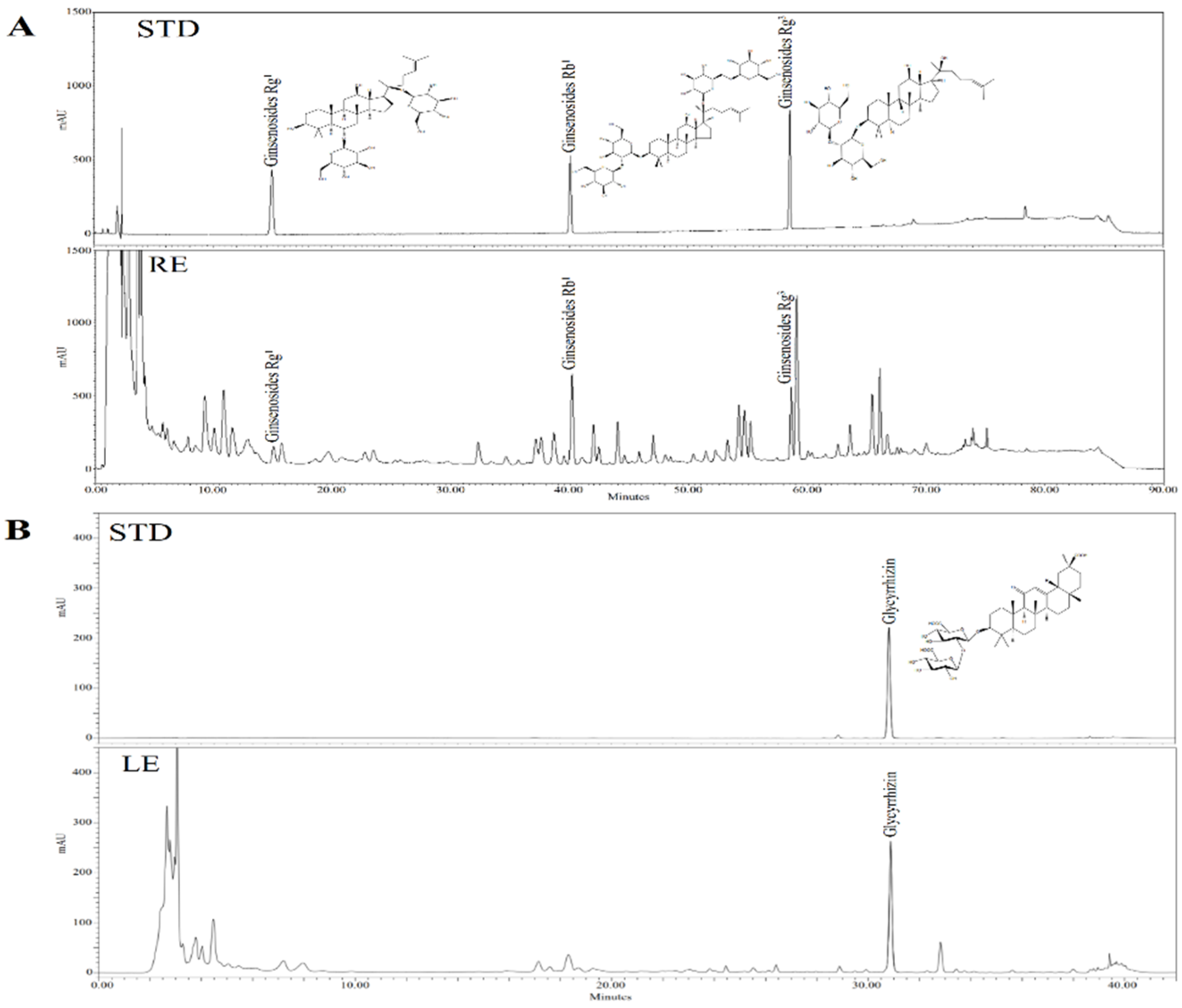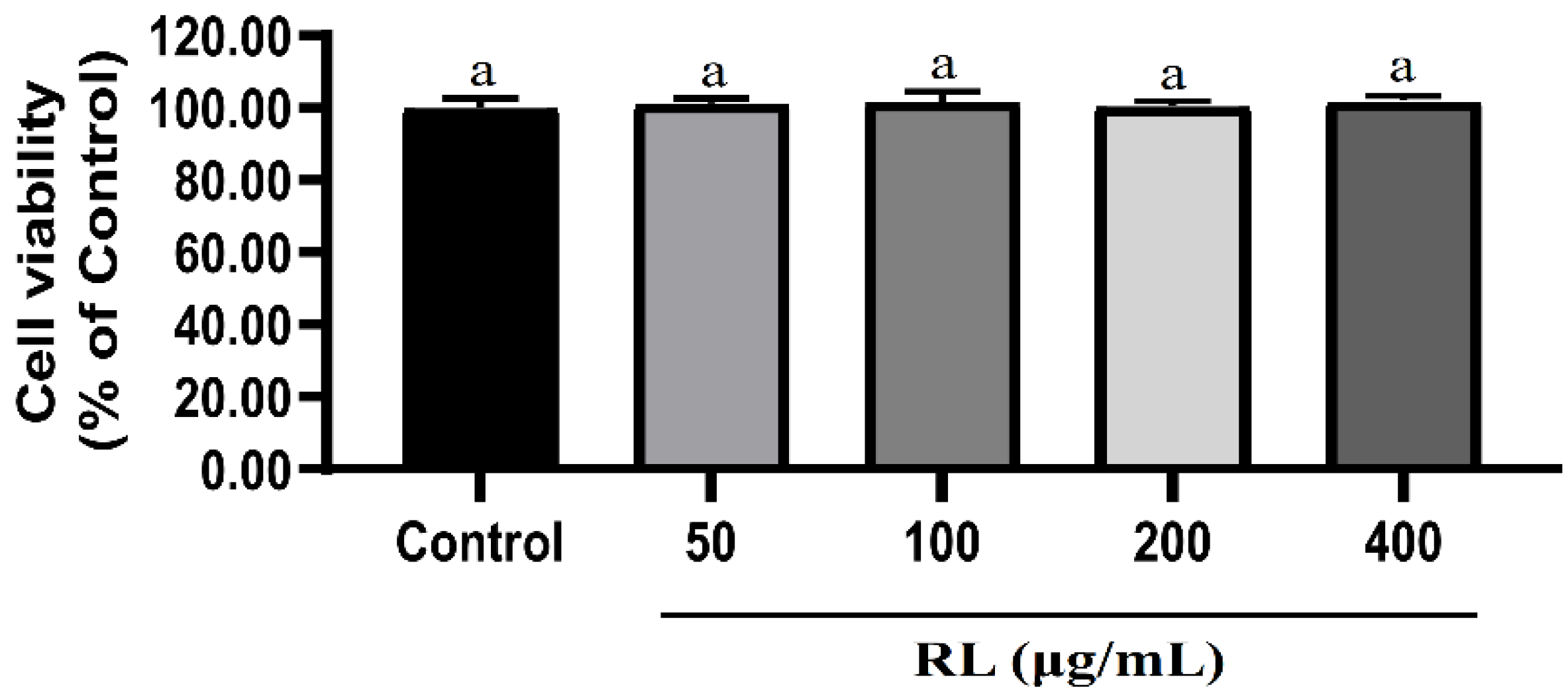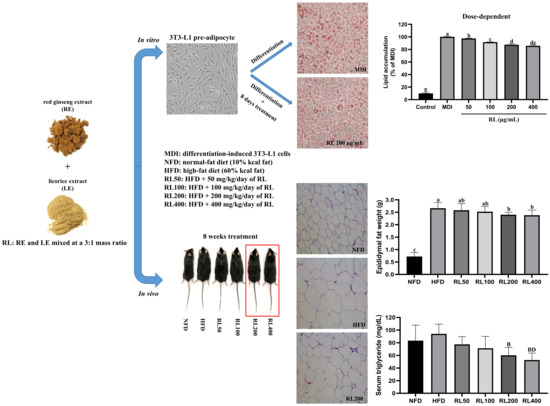Preclinical Research on a Mixture of Red Ginseng and Licorice Extracts in the Treatment and Prevention of Obesity
Abstract
1. Introduction
2. Materials and Methods
2.1. Materials
2.2. Preparation of Sample
2.3. HPLC Analysis
2.4. Cell Culture and Differentiation
2.5. Cell Viability
2.6. Lipid Accumulation Assay
2.7. Mice and Diets
2.8. Histological Analysis
2.9. Immunoblot Assay
2.10. Statistical Analysis
3. Results
3.1. Composition of RE and LE
3.2. High Concentrations of RL Did Not Cause Cytotoxicity
3.3. Different Concentrations of RL Have Different Inhibitory Rates on Lipid Accumulation
3.4. Suppression of Adipogenic and Lipogenic Transcription Factors by Different Concentrations of RL
3.5. RL Can Improve Various Physiological Indicators of Obese Mice
3.6. RL Attenuates Adipocyte Hypertrophy
3.7. RL Can Reduce Blood Lipids in Obese Mice
3.8. RL Activates the AMPK Pathway in a Dose-Dependent Manner
4. Discussion
5. Conclusions
Author Contributions
Funding
Conflicts of Interest
References
- Kopelman, P. Health risks associated with overweight and obesity. Obes. Rev. 2007, 8, 13–17. [Google Scholar] [CrossRef]
- Jastreboff, A.M.; Kotz, C.M.; Kahan, S.; Kelly, A.S.; Heymsfield, S.B. Obesity as a disease: The obesity society 2018 position statement. Obesity 2019, 27, 7–9. [Google Scholar] [CrossRef] [PubMed]
- Payab, M.; Hasani-Ranjbar, S.; Aletaha, A.; Ghasemi, N.; Qorbani, M.; Atlasi, R.; Abdollahi, M.; Larijani, B. Efficacy, safety, and mechanisms of herbal medicines used in the treatment of obesity: A protocol for systematic review. Medicine 2018, 97, e8825. [Google Scholar] [CrossRef] [PubMed]
- Wirth, A.; Wabitsch, M.; Hauner, H. The prevention and treatment of obesity. Dtsch. Arztebl. Int. 2014, 111, 705–713. [Google Scholar] [CrossRef] [PubMed]
- Kang, J.G.; Park, C.-Y. Anti-obesity drugs: A review about their effects and safety. Diabetes Metab. J. 2012, 36, 13–25. [Google Scholar] [CrossRef]
- Sun, N.-N.; Wu, T.-Y.; Chau, C.-F. Natural dietary and herbal products in anti-obesity treatment. Molecules 2016, 21, 1351. [Google Scholar] [CrossRef]
- Lai, C.-S.; Wu, J.-C.; Pan, M.-H. Molecular mechanism on functional food bioactives for anti-obesity. Curr. Opin. Food Sci. 2015, 2, 9–13. [Google Scholar] [CrossRef]
- Patra, S.; Nithya, S.; Srinithya, B.; Meenakshi, S. Review of medicinal plants for anti-obesity activity. Transl. Biomed. 2015, 6, 1–23. [Google Scholar] [CrossRef]
- Karri, S.; Sharma, S.; Hatware, K.; Patil, K. Natural anti-obesity agents and their therapeutic role in management of obesity: A future trend perspective. Biomed. Pharmacother. 2019, 110, 224–238. [Google Scholar] [CrossRef]
- Qi, Z. Who Traditional Medicine Strategy 2014–2023; World Health Organization: Geneva, Switzerland, 2013. [Google Scholar]
- Marrelli, M.; Amodeo, V.; Statti, G.; Conforti, F. Biological properties and bioactive components of Allium cepa L.: Focus on potential benefits in the treatment of obesity and related comorbidities. Molecules 2019, 24, 119. [Google Scholar] [CrossRef]
- Lee, S.M.; Bae, B.-S.; Park, H.-W.; Ahn, N.-G.; Cho, B.-G.; Cho, Y.-L.; Kwak, Y.-S. Characterization of Korean Red Ginseng (Panax ginseng Meyer): History, preparation method, and chemical composition. J. Ginseng Res. 2015, 39, 384–391. [Google Scholar] [CrossRef] [PubMed]
- Mamedov, N.A.; Egamberdieva, D. Phytochemical Constituents and Pharmacological Effects of Licorice: A Review. Plant Hum. Health 2019, 3, 1–21. [Google Scholar]
- Yang, R.; Yuan, B.-C.; Ma, Y.-S.; Zhou, S.; Liu, Y. The anti-inflammatory activity of licorice, a widely used Chinese herb. Pharm. Biol. 2017, 55, 5–18. [Google Scholar] [CrossRef] [PubMed]
- Lo, H.-Y.; Hsiang, C.-Y.; Li, T.-C.; Li, C.-C.; Huang, H.-C.; Chen, J.-C.; Ho, T.-Y. A novel glycated hemoglobin A1c-lowering traditional Chinese medicinal formula, identified by translational medicine study. PLoS ONE 2014, 9, e104650. [Google Scholar] [CrossRef] [PubMed]
- Chen, C.-C.; Hsiang, C.-Y.; Chiang, A.-N.; Lo, H.-Y.; Li, C.-I. Peroxisome proliferator-activated receptor gamma transactivation-mediated potentiation of glucose uptake by Bai-Hu-Tang. J. Ethnopharmacol. 2008, 118, 46–50. [Google Scholar] [CrossRef]
- Kimura, I.; Nakashima, N.; Sugihara, Y.; Fu-j6un, C.; Kimura, M. The antihyperglycaemic blend effect of traditional Chinese medicine Byakko-ka-ninjin-to on alloxan and diabetic KK-CAy mice. Phytother. Res. 1999, 13, 484–488. [Google Scholar] [CrossRef]
- Guo, T.L.; Chi, R.P.; Fu, J.; White, K.L. Immunomodulation in female B6C3F1 mice following treatment with Chai-Ling-Tang, a formula consisting of twelve herbs. Orient. Pharm. Exp. Med. 2011, 11, 91–99. [Google Scholar] [CrossRef]
- Kim, J.K.; Tabassum, N.; Uddin, M.R.; Park, S.U. Ginseng: A miracle sources of herbal and pharmacological uses. Orient. Pharm. Exp. Med. 2016, 16, 243–250. [Google Scholar] [CrossRef]
- Guo, J.; Shang, E.; Zhao, J.; Fan, X.; Duan, J.; Qian, D.; Tao, W.; Tang, Y. Data mining and frequency analysis for licorice as a “Two-Face” herb in Chinese Formulae based on Chinese Formulae Database. Phytomedicine 2014, 21, 1281–1286. [Google Scholar] [CrossRef]
- Kim, J.H.; Hahm, D.H.; Yang, D.C.; Kim, J.H.; Lee, H.J.; Shim, I. Effect of crude saponin of Korean Red Ginseng on high fat diet-induced obesity in the rat. J. Pharmacol. Sci. 2005, 97, 124–131. [Google Scholar] [CrossRef]
- Malik, Z.A.; Sharma, P.L. An ethanolic extract from licorice (glycyrrhiza glabra) exhibits anti-obesity effects by decreasing dietary fat absorption in a high fat diet-induced obesity rat model. Int. J. Pharm. Sci. Res. 2011, 2, 3010–3018. [Google Scholar]
- Popovich, D.G.; Yeo, S.Y.; Zhang, W. Ginseng (Panax quinquefolius) and Licorice (Glycyrrhiza uralensis) root extract combinations increase hepatocarcinoma cell (Hep-G2) viability. Evid.-Based Complement. Altern. Med. 2011, 2011, 408273. [Google Scholar] [CrossRef] [PubMed]
- Kim, K.-Y.; Lee, H.N.; Kim, Y.J.; Park, T. Garcinia cambogia extract ameliorates visceral adiposity in C57BL/6J mice fed on a high-fat diet. Biosci. Biotechnol. Biochem. 2008, 72, 1772–1780. [Google Scholar] [CrossRef] [PubMed]
- Zheng, Y.; Lee, J.; Shin, K.-O.; Park, K.; Kang, I.-J. Synergistic action of Erigeron annuus L. Pers and Borago officinalis L. enhances anti-obesity activity in a mouse model of diet-induced obesity. Nutr. Res. 2019, 69, 58–66. [Google Scholar] [CrossRef] [PubMed]
- Azzini, E.; Giacometti, J.; Russo, G.L. Antiobesity effects of anthocyanins in preclinical and clinical studies. Oxidative Med. Cell. Longev. 2017, 2017, 1–11. [Google Scholar] [CrossRef] [PubMed]
- Nair, A.B.; Jacob, S. A simple practice guide for dose conversion between animals and human. J. Basic Clin. Pharm. 2016, 7, 27–31. [Google Scholar] [CrossRef] [PubMed]
- Lowe, C.E.; O’Rahilly, S.; Rochford, J.J. Adipogenesis at a glance. J. Cell Sci. 2011, 124, 2681–2686. [Google Scholar] [CrossRef]
- White, U.A.; Stephens, J.M. Transcriptional factors that promote formation of white adipose tissue. Mol. Cell. Endocrinol. 2010, 318, 10–14. [Google Scholar] [CrossRef]
- Yoo, S.-R.; Seo, C.-S.; Shin, H.-K.; Jeong, S.-J. Traditional herbal formula oyaksungi-san inhibits adipogenesis in 3T3-L1 adipocytes. Evid.-Based Complement. Altern. Med. 2015, 2015, 949461. [Google Scholar] [CrossRef]
- Liu, H.; Wang, J.; Liu, M.; Zhao, H.; Yaqoob, S.; Zheng, M.; Cai, D.; Liu, J. Antiobesity effects of ginsenoside Rg1 on 3T3-L1 preadipocytes and high fat diet-induced obese mice mediated by AMPK. Nutrients 2018, 10, 830. [Google Scholar] [CrossRef]
- Hwang, J.T.; Lee, M.S.; Kim, H.J.; Sung, M.J.; Kim, H.Y.; Kim, M.S.; Kwon, D.Y. Antiobesity effect of ginsenoside Rg3 involves the AMPK and PPAR-γ signal pathways. Phytother. Res. 2009, 23, 262–266. [Google Scholar] [CrossRef] [PubMed]
- Shang, W.; Yang, Y.; Jiang, B.; Jin, H.; Zhou, L.; Liu, S.; Chen, M. Ginsenoside Rb1 promotes adipogenesis in 3T3-L1 cells by enhancing PPARγ2 and C/EBPα gene expression. Life Sci. 2007, 80, 618–625. [Google Scholar] [CrossRef] [PubMed]
- Eu, C.H.A.; Lim, W.Y.A.; Ton, S.H.; bin Abdul Kadir, K. Glycyrrhizic acid improved lipoprotein lipase expression, insulin sensitivity, serum lipid and lipid deposition in high-fat diet-induced obese rats. Lipids Health Dis. 2010, 9, 81–90. [Google Scholar] [CrossRef] [PubMed]
- Chintharlapalli, S.; Papineni, S.; Jutooru, I.; McAlees, A.; Safe, S. Structure-dependent activity of glycyrrhetinic acid derivatives as peroxisome proliferator–activated receptor γ agonists in colon cancer cells. Mol. Cancer Ther. 2007, 6, 1588–1598. [Google Scholar] [CrossRef]
- Park, M.; Lee, J.H.; Choi, J.K.; Hong, Y.D.; Bae, I.H.; Lim, K.M.; Park, Y.H.; Ha, H. 18β-glycyrrhetinic acid attenuates anandamide-induced adiposity and high-fat diet induced obesity. Mol. Nutr. Food Res. 2014, 58, 1436–1446. [Google Scholar] [CrossRef]
- Qi, L.-W.; Wang, C.-Z.; Du, G.-J.; Zhang, Z.-Y.; Calway, T.; Yuan, C.-S. Metabolism of ginseng and its interactions with drugs. Curr. Drug Metab. 2011, 12, 818–822. [Google Scholar] [CrossRef]
- Lee, S.-Y.; Jeong, J.-J.; Eun, S.-H.; Kim, D.-H. Anti-inflammatory effects of ginsenoside Rg1 and its metabolites ginsenoside Rh1 and 20 (S)-protopanaxatriol in mice with TNBS-induced colitis. Eur. J. Pharmacol. 2015, 762, 333–343. [Google Scholar] [CrossRef]
- Liu, C.; Hu, M.; Guo, H.; Zhang, M.; Zhang, J.; Li, F.; Zhong, Z.; Chen, Y.; Li, Y.; Xu, P. Combined contribution of increased intestinal permeability and inhibited deglycosylation of ginsenoside Rb1 in the intestinal tract to the enhancement of ginsenoside Rb1 exposure in diabetic rats after oral administration. Drug Metab. Dispos. 2015, 43, 1702–1710. [Google Scholar] [CrossRef]
- Qian, T.; Cai, Z. Biotransformation of ginsenosides Rb 1, Rg 3 and Rh 2 in rat gastrointestinal tracts. Chin. Med. 2010, 5, 19–27. [Google Scholar] [CrossRef]
- Mohanan, P.; Subramaniyam, S.; Mathiyalagan, R.; Yang, D.-C. Molecular signaling of ginsenosides Rb1, Rg1, and Rg3 and their mode of actions. J. Ginseng Res. 2018, 42, 123–132. [Google Scholar] [CrossRef]
- Hwang, J.-T.; Kim, S.-H.; Lee, M.-S.; Kim, S.H.; Yang, H.-J.; Kim, M.-J.; Kim, H.-S.; Ha, J.; Kim, M.S.; Kwon, D.Y. Anti-obesity effects of ginsenoside Rh2 are associated with the activation of AMPK signaling pathway in 3T3-L1 adipocyte. Biochem. Biophys. Res. Commun. 2007, 364, 1002–1008. [Google Scholar] [CrossRef] [PubMed]
- Kim, D.Y.; Yuan, H.D.; Chung, I.K.; Chung, S.H. Compound K, intestinal metabolite of ginsenoside, attenuates hepatic lipid accumulation via AMPK activation in human hepatoma cells. J. Agric. Food Chem. 2009, 57, 1532–1537. [Google Scholar] [CrossRef] [PubMed]
- Day, E.A.; Ford, R.J.; Steinberg, G.R. AMPK as a therapeutic target for treating metabolic diseases. Trends Endocrinol. Metab. 2017, 28, 545–560. [Google Scholar] [CrossRef] [PubMed]
- Dzamko, N.; Steinberg, G. AMPK-dependent hormonal regulation of whole-body energy metabolism. Acta Physiol. 2009, 196, 115–127. [Google Scholar] [CrossRef]
- Ke, R.; Xu, Q.; Li, C.; Luo, L.; Huang, D. Mechanisms of AMPK in the maintenance of ATP balance during energy metabolism. Cell Biol. Int. 2018, 42, 384–392. [Google Scholar] [CrossRef]






| Parameter | NFD | HFD | GC200 | RL50 | RL100 | RL200 | RL400 |
|---|---|---|---|---|---|---|---|
| Initial body weight (g) | 21.63 ± 0.63 a | 21.61 ± 0.72 a | 21.51 ± 0.73 a | 21.56 ± 0.30 a | 21.58 ± 0.81 a | 21.69 ± 0.54 a | 21.50 ± 0.56 a |
| Final body weight (g) | 30.83 ± 1.54 c | 45.36 ± 2.53 a | 41.83 ± 2.47 b | 43.13 ± 2.32 a,b | 43.06 ± 4.52 a,b | 41.94 ± 2.53 b | 41.67 ± 3.77 b |
| Body weight gain (g) | 9.19 ± 1.65 c | 23.75 ± 2.41 a | 20.32 ± 2.39 b | 21.57 ± 2.34 a,b | 21.48 ± 4.46 a,b | 20.25 ± 2.32 b | 20.17 ± 3.81 b |
| Parameter | NFD | HFD | GC200 | RL50 | RL100 | RL200 | RL400 |
|---|---|---|---|---|---|---|---|
| Food intake (g/day) | 2.74 ± 0.13 a | 2.87 ± 0.12 a | 2.87 ± 0.22 a | 2.74 ± 0.15 a | 2.73 ± 0.23 a | 2.75 ± 0.13 a | 2.88 ± 0.10 a |
| Water intake (g/day) | 3.01 ± 0.42 a | 2.99 ± 0.57 a | 2.57 ± 0.54 a | 2.91 ± 0.46 a | 2.58 ± 0.40 a | 2.90 ± 0.42 a | 3.02 ± 0.51 a |
| Energy intake (Kcal/day) | 10.14 ± 0.49 b | 14.62 ± 0.61 a | 14.62 ± 1.13 a | 13.96 ± 0.78 a | 13.91 ± 1.18 a | 14.05 ± 0.65 a | 14.69 ± 0.51 a |
| FER (%) | 4.78 ± 0.82 b | 11.67 ± 3.07 a | 10.01 ± 2.06 a | 10.96 ± 2.34 a | 11.34 ± 1.99 a | 10.17 ± 1.52 a | 9.80 ± 1.77 a |
| Parameter | NFD | HFD | GC200 | RL50 | RL100 | RL200 | RL400 |
|---|---|---|---|---|---|---|---|
| Liver (g) | 1.02 ± 0.12 c | 1.52 ± 0.30 a | 1.19 ± 0.07 b,c | 1.24 ± 0.25 b | 1.18 ± 0.10 b,c | 1.10 ± 0.14 b,c | 1.15 ± 0.18 b,c |
| Kidney (g) | 0.27 ± 0.03 a | 0.30 ± 0.03 a | 0.29 ± 0.01 a | 0.29 ± 0.03 a | 0.30 ± 0.04 a | 0.29 ± 0.02 a | 0.29 ± 0.02 a |
| Spleen (g) | 0.06 ± 0.01 a | 0.06 ± 0.01 a | 0.06 ± 0.01 a | 0.06 ± 0.01 a | 0.06 ± 0.01 a | 0.06 ± 0.01 a | 0.06 ± 0.01 a |
| Epididymal fat (g) | 0.72 ± 0.16 c | 2.66 ± 0.23 a | 2.35 ± 0.20 b | 2.58 ± 0.27 a,b | 2.52 ± 0.21 a,b | 2.40 ± 0.10 b | 2.38 ± 0.21 b |
| Visceral fat (g) | 0.22 ± 0.09 c | 1.14 ± 0.35 a | 0.75 ± 0.23 b | 0.99 ± 0.44 a,b | 0.89 ± 0.35 a,b | 0.83 ± 0.25 b | 0.77 ± 0.37 b |
| Parameter | NFD | HFD | GC200 | RL50 | RL100 | RL200 | RL400 |
|---|---|---|---|---|---|---|---|
| ALT (U/L) | 24.88 ± 5.51 | 69.75 ± 35.94 | 53.00 ± 19.03 | 48.75 ± 31.69 | 48.88 ± 16.63 | 40.38 ± 13.64 | 38.63 ± 20.30 |
| AST (U/L) | 77.63 ± 18.88 a | 97.88 ± 64.02 a | 78.50 ± 21.86 a | 70.50 ± 25.14 a | 73.38 ± 15.99 a | 72.75 ± 26.93 a | 64.50 ± 10.99 a |
| GLU (mg/dL) | 195.88 ± 43.04 b | 298.00 ± 44.14 a | 268.63 ± 47.44 a | 267.13 ± 55.78 a | 281.75 ± 45.39 a | 261.25 ± 33.65 a | 266.38 ± 31.63 a |
| TG (mg/dL) | 83.25 ± 24.56 | 94.00 ± 15.37 | 88.67 ± 17.12 | 77.38 ± 12.28 | 71.13 ± 18.93 | 60.13 ± 12.35 B | 52.63 ± 10.99 B,D |
| TC (mg/dL) | 122.25 ± 6.78 b | 181.88 ± 10.91 a | 180.25 ± 17.12 a | 175.88 ± 16.49 a | 179.88 ± 14.10 a | 172.25 ± 9.38 a | 170.38 ± 13.71 a |
| HDL-C (mg/dL) | 81.63 ± 12.40 b | 126.25 ± 18.91 a | 132.25 ± 11.89 a | 131.75 ± 9.74 a | 137.63 ± 14.57 a | 130.38 ± 12.14 a | 136.63 ± 9.75 a |
| LDL-C (mg/dL) | 16.35 ± 3.08 | 30.58 ± 9.00 A | 25.58 ± 2.51 A | 28.65 ± 9.92 | 28.03 ± 6.46 A | 27.18 ± 9.82 | 26.68 ± 4.45 A |
© 2020 by the authors. Licensee MDPI, Basel, Switzerland. This article is an open access article distributed under the terms and conditions of the Creative Commons Attribution (CC BY) license (http://creativecommons.org/licenses/by/4.0/).
Share and Cite
Zheng, Y.; Lee, E.-H.; Lee, J.-H.; In, G.; Kim, J.; Lee, M.-H.; Lee, O.-H.; Kang, I.-J. Preclinical Research on a Mixture of Red Ginseng and Licorice Extracts in the Treatment and Prevention of Obesity. Nutrients 2020, 12, 2744. https://doi.org/10.3390/nu12092744
Zheng Y, Lee E-H, Lee J-H, In G, Kim J, Lee M-H, Lee O-H, Kang I-J. Preclinical Research on a Mixture of Red Ginseng and Licorice Extracts in the Treatment and Prevention of Obesity. Nutrients. 2020; 12(9):2744. https://doi.org/10.3390/nu12092744
Chicago/Turabian StyleZheng, Yulong, Eun-Hye Lee, Ji-Hyun Lee, Gyo In, JongHan Kim, Mi-Hyang Lee, Ok-Hwan Lee, and Il-Jun Kang. 2020. "Preclinical Research on a Mixture of Red Ginseng and Licorice Extracts in the Treatment and Prevention of Obesity" Nutrients 12, no. 9: 2744. https://doi.org/10.3390/nu12092744
APA StyleZheng, Y., Lee, E.-H., Lee, J.-H., In, G., Kim, J., Lee, M.-H., Lee, O.-H., & Kang, I.-J. (2020). Preclinical Research on a Mixture of Red Ginseng and Licorice Extracts in the Treatment and Prevention of Obesity. Nutrients, 12(9), 2744. https://doi.org/10.3390/nu12092744







